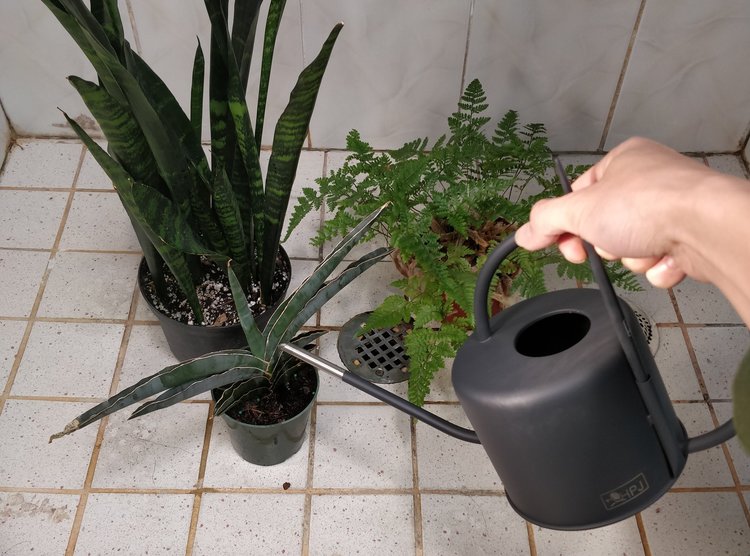You hear these all the time:
- Overwatering is the number one killer of houseplants
- It’s better to underwater than to overwater
- If your leaves are yellowing, you might be overwatering
The constant use of the term ‘overwatering’ is causing undue anxiety because it makes you fixate on “watering properly”, in the hopes that you’ll avoid root rot and your plant will grow well.
Here’s the thing: watering too frequently or too deeply are not the main contributors to root rot.
Water mold organisms in the genus Phytophthora are the main culprits of root rot – they thrive in
- High moisture
- Low oxygen
- They infect weak roots
The concept of ‘overwatering’ only addresses the “high moisture” that Phytophthora like. Low oxygen comes from poorly aerated soil – the way to mitigate this is with regular soil aeration (gently poking the soil with a chopstick) and using porous/well-draining components in soil, such as perlite.
The last point, weak roots, is a much longer term condition to get to. Just like a starving person is more susceptible to illness, a starving plant will be at higher risk of root rot whenever the soil becomes moist and stale. A plant starves when it is in prolonged conditions of poor lighting. So when you water a plant in this condition, the soil moisture lingers. Put the same plant where you know the light is good (because you’ve measured it), roots will be strong as the entire plant is working. So when you do moisten the soil, the roots will take up the water and use it to make sugars to feed itself. Therefore, good light is the key to preventing root rot.
This is why a plant can still grow poorly and eventually get root rot even if you waited until the soil was completely dry between watering – if the lighting is poor, the plant is starving and has weak roots, which are more susceptible to root rot.
Side note: please stop thinking of fertilizer as “feeding” the plant, as in, providing daily sustenance. Fertilizers are necessary for building the cellular structures of the plant but the carbohydrates for energy are made from photosynthesis. There is no replacement for light!

So warning about ‘overwatering’ should really be replaced by advice on where you should put your plants to prevent poor plant nourishment. My guideline for plant placement is this: ask #whatmyplantsees – make sure your plant has the widest possible view of the sky and check for its tolerance for direct sun (i.e. number of hours it can tolerate). In this position, assuming your soil is compatible with the particular plant, you can safely bring the soil to saturation because the plant will be receiving enough light to use up the soil moisture before root rot can take hold. This is the fundamental principle of plant care. It’s not even enough to use all the most porous soil with the best drainage and terracotta pots – all you’re doing is getting the soil to dry out by evaporation. You want the soil to become dry because the plant is using it for photosynthesis – therefore, proper light is the prerequisite of proper plant care.
So what about actually watering? How do I know when to water a plant?
A confusing approach to determining WHEN to water a plant is asking “how often do I water this plant?” — assuming that a specific plant has a specific watering frequency that is written in stone. This is the wrong approach!
When you start with good light, the smarter approach to know WHEN to water a plant is based on observing soil dryness level – there are only three broad dryness levels that will be your cue to water:
- When the soil is *completely dry* (applies to succulents, cacti, and most thick-leaved plants like zz plant)
- When the soil is *partially dry* (applies to the majority of tropical foliage plants)
- Keep the soil *evenly moist* (applies to very thin-leaved plants that are prone to wilting, especially maidenhair fern)
Here’s a video explaining this concept further:
I realize a change in the approach to house plant care won’t happen overnight. You’ll definitely still encounter the term ‘overwatering’ but, instead of thinking “Oh, I need to be more careful with watering”, you should consider whether you are giving your plant the best possible light in your home – and when you start measuring light, you will realize the term ‘bright indirect light’ is meaningless. A light meter will tell you that there is far too much variance in terms of window size, distance from the window, external obstructions, etc for there to be a singular ‘bright indirect light’ that is the same for everyone. Measure your light and refer to this chart – your plants will thank you!
Start with a better understanding of light and you’ll have a more rewarding experience with house plant care.
I created this online course that cuts through confusing do’s and don’ts by teaching you the principles of how plants work – so you can confidently do what’s best for your houseplants: